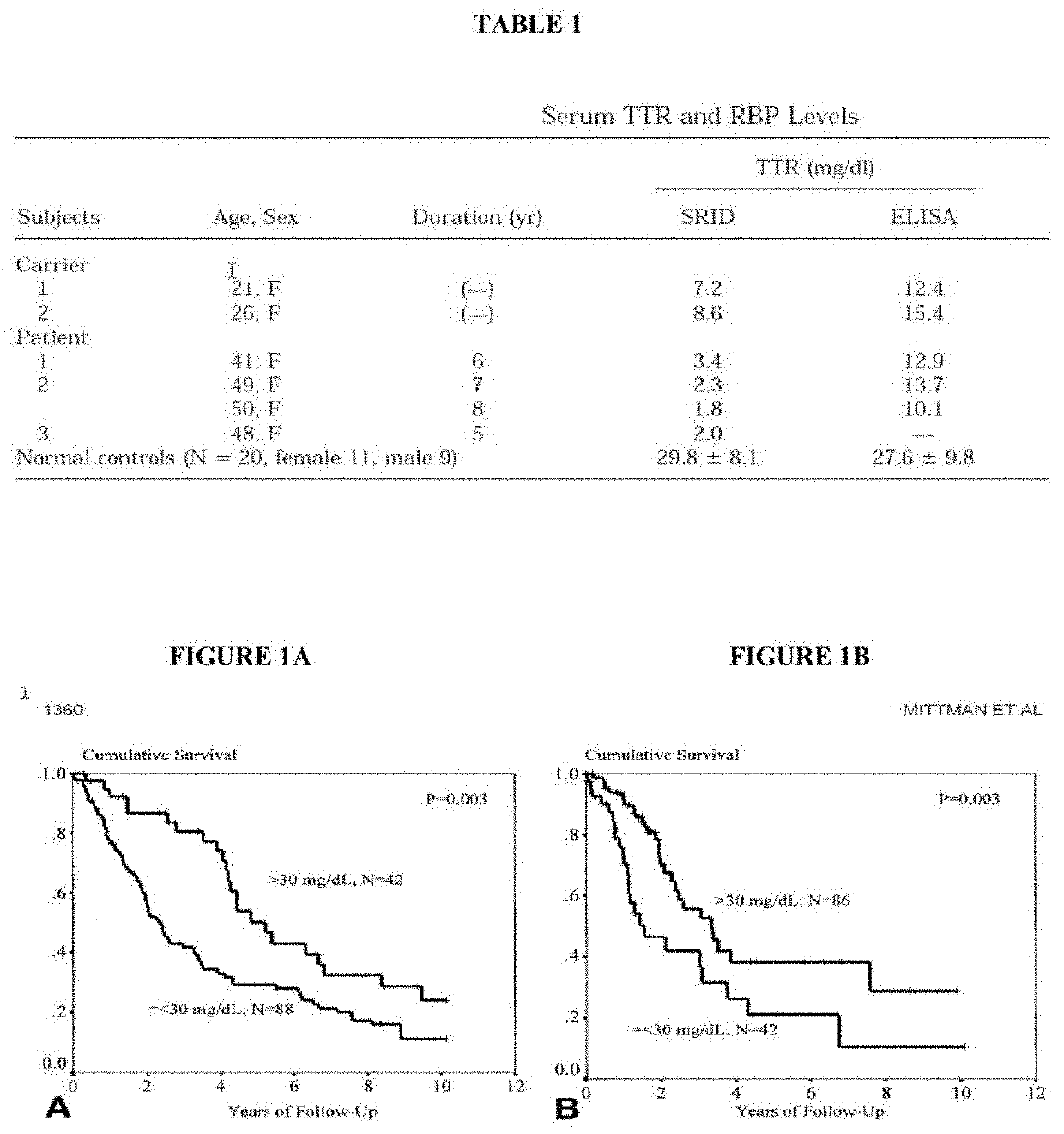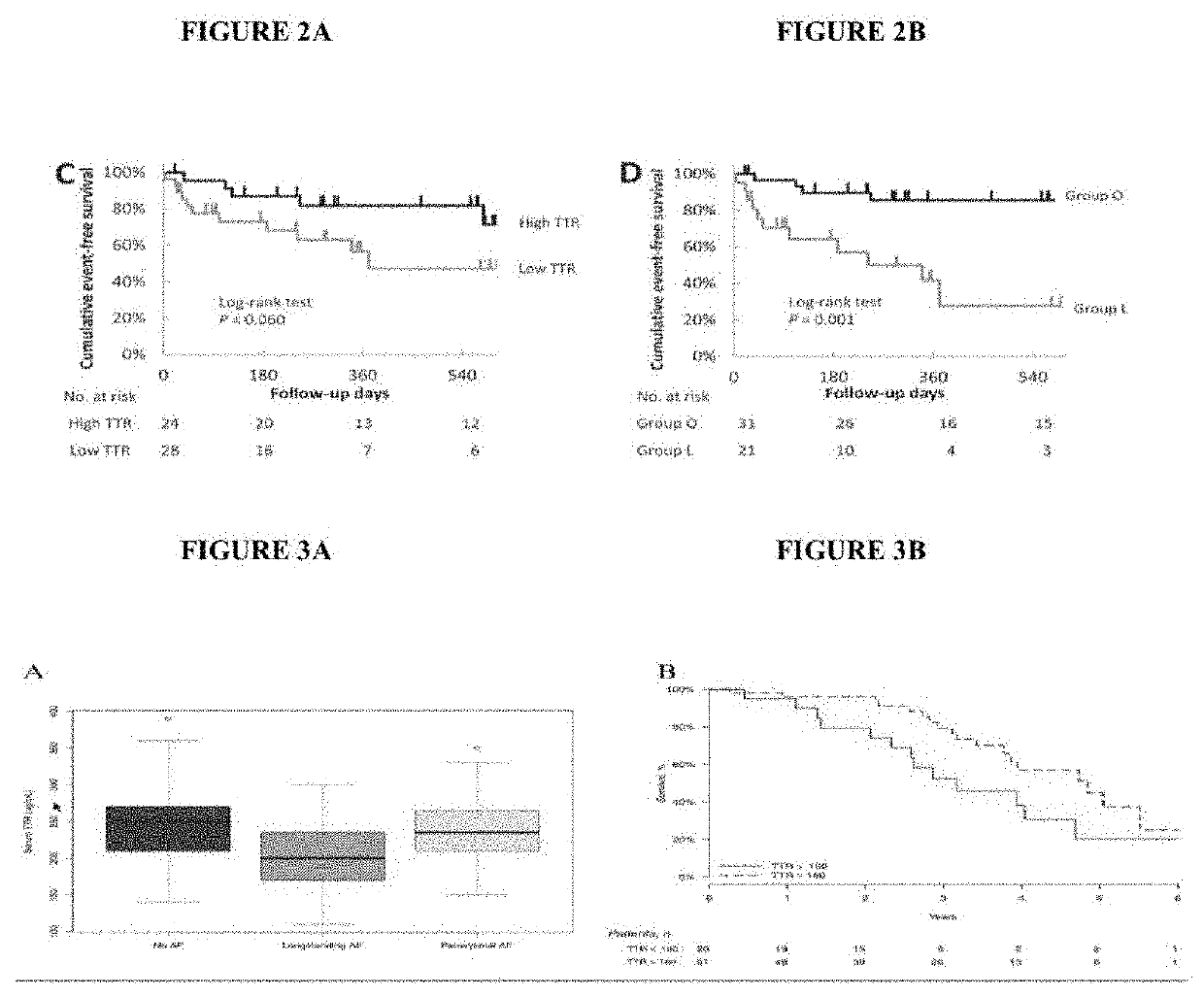Methodologies and methods for measuring higher molecular weight transthyretin or equivalents as a clinical biomarker
a technology of transthyretin and molecular weight, applied in the field of clinical biomarkers, can solve problems such as damage to human tissues/organs, and achieve the effect of cost-effectiveness
- Summary
- Abstract
- Description
- Claims
- Application Information
AI Technical Summary
Benefits of technology
Problems solved by technology
Method used
Image
Examples
example 1
Assay Dependency of TTR Levels from Same Patients
[0130]One study used two different methods to measure TTR levels in either asymptomatic or symptomatic hereditary ATTR patients with Y114C amino acid change (see Ando, Yukio, et al Biochemical and Biophysical Research Communications 1999). The two methods, single radial immunodiffusion (SRID) and enzyme-linked immunosorbent assay (ELISA), despite being run on samples from the same patients, measured significantly different TTR levels. In carriers (asymptomatic), SRID vs ELISA measured mean TTR levels of 7.9 mg / dL vs 13.9 mg / dL, respectively. In symptomatic patients, SRID vs ELISA measured mean TTR levels of 2.3 mg / dL (n=4) vs 12.2 mg / dL (n=3), respectively (Table 1). This is in contrast to normal controls, where both assays measured similar TTR values that were also higher (˜29.8 mg / dL). These findings are important because they not only demonstrate the impact which assay used can have on TTR levels, but they show how diseased populat...
example 2
Cancer Relevance; Improved Survival for AL with Greater HMW TTR Levels
[0133]Immunoglobulin light chain amyloidosis (AL) is both a cancer and a proteinopathy. AL is associated with other cancers that also produce clonal immunoglobulin light chains (LC) of kappa or lambda type including multiple myeloma and monoclonal gammopathy of undetermined significance (MGUS). AL is also associated with B-cell lymphomas and Waldenstrom macroglobulinemia. Given similar pathophysiology between AL and MM, it is not surprising that treatments which work for multiple myeloma also work for AL. Of note, despite AL being a cancer, the most common cause of death in this population is cardiac-related. The most common causes of death in ATTR-cardiomyopathy (ATTR-CM) is also cardiac-related. A recent publication comparing ATTR-CM and AL showed that AL patients have a significantly greater risk of death compared to ATTR-CM (HR 3.02, 2.47-3.7, p<0.001) (see Xin et al., “Prognostic impact of light-chain and tra...
example 3
ATTR, Hemodialysis, Acute Heart Failure; Lower HMW TTR Levels Correlate with Poorer Clinical Outcomes
[0140]The methods provided herein demonstrate that a minimum TTR tetramer concentration and / or its functionally equivalent in a biological sample is needed such that less than a certain threshold indicates increased risk of a poor clinical outcome. Using such methods, for serum derived biological samples, levels of 18-20 mg / dL provide a starting threshold level where subjects may be at increased risk of a poor clinical outcome related to a diagnosed or an undiagnosed disease.
[0141]The methods provided herein also demonstrate that the risk of a poor clinical outcome increases with further reductions in TTR tetramer levels and / or functional equivalents. Statistical analyses across patients with different diseases in-fact have demonstrated every 1 mg / dL reduction in TTR tetramer levels increased the risk of death by ˜7-11%. Data comes from three independent studies by three different gr...
PUM
 Login to View More
Login to View More Abstract
Description
Claims
Application Information
 Login to View More
Login to View More - R&D
- Intellectual Property
- Life Sciences
- Materials
- Tech Scout
- Unparalleled Data Quality
- Higher Quality Content
- 60% Fewer Hallucinations
Browse by: Latest US Patents, China's latest patents, Technical Efficacy Thesaurus, Application Domain, Technology Topic, Popular Technical Reports.
© 2025 PatSnap. All rights reserved.Legal|Privacy policy|Modern Slavery Act Transparency Statement|Sitemap|About US| Contact US: help@patsnap.com



